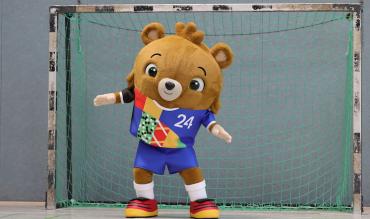Less than a handful of months are left until we’re treated to one of the biggest soccer spectacles in the world: UEFA Euro 2024.
Of course, there’s a lot of sports betting Ontario natives can delve into in the meantime, like the MLS, Premier League, and UEFA Champions League markets, but once June arrives, all focus turns to Euro 2024 in Europe.
While national team mascots aren’t exactly commonplace, tournament mascots are in soccer, and for Euro 2024, Germany has bucked a dull trend to deliver a loveable and perhaps even an iconic mascot.
Here’s what you need to know about the Euro 2024 mascot and where it ranks among the other mascots of the UEFA European Football Championship.
What is the Euro 2024 Mascot?
The Euro 2024 mascot is a cute teddy bear wearing soccer boots in the colours of the German national flag.
The teddy bear toy is said to have originated in Germany, lending the mascot to the country’s history.
Completing the look is the multi-coloured shirt, featuring blue, yellow, green, and red panels, one which is green with black and white spots, and another which is red with yellow and white crosses.
What is the Euro 2024 Mascot’s Name?
A vote was held on the official UEFA website to determine the name of the Euro 2024 mascot. The options were all plays on the German word for “bear,” which is “bär.“
Bärnardo was said to be a bear for the world stage, while Bärnheart was all about uniting the soccer community in Europe. Herzi von Bär would have been a bear who lives for the game.
The winner, with 32 percent of the vote, was Albärt, hailed as the “perfect companion for any football fan.”
Once Albärt was announced on June 20, 2023, the mascot went about promoting the sport and the upcoming tournament, which included a trip to the US to meet some fellow mascots.
What Does the Euro 2024 Mascot Do?
The Euro 2024 mascot, Albärt, is there to inspire children to play the sport, go to stadiums, and connect with the teams and star players from around the world.
Intended to be an inspiring character who’s fun and likeable, Albärt will be touring European schools, popping up at games, around stadiums, meeting fans, and putting on mini-events and challenges to make each occasion all the more enjoyable.
Of course, as the home mascot, German fans will be hoping that Albärt brings some luck to the team.
The hosts have only won the Euros three times, so Albärt will need to be extra lucky to make good on Germany’s +600 soccer odds to win it in 2024.
How Does the Euro 2024 Mascot Compare to Other Euros Mascots?
Considering the last four mascot outings, it’d be fair to say that Albärt ranks as the best Euros mascot in a very long time who can succeed in the tournament ambassador’s hopes of “delivering that powerful message.”
Perhaps the most disappointing of all Euros mascots was Skillzy for UEFA Euro 2020, which took place across the continent. It was an overtly desperate attempt to connect to trick-loving youths with what was just a skilful person.
Before Skillzy, at least Super Victor in France had a superhero outfit, but was still just a generic human. Slavek and Slavko for the Poland-Ukraine 2012 Euros followed on from Trix and Flix four years before.
Both of those mascot duos were just two people with zany hair. Kinas, for Portugal in 2004, kicked off this trend of just having a human mascot, so you need to go back to Euro 2000 to see the last creative one.
You’ve got the devilish Benelucky (Netherlands-Belgium, 2000), the hefty lion Goliath (England, 1996), Rabbit the rabbit (Sweden, 1992), Berni the rabbit (West Germany, 1988), Peno the cockerel (France, 1984), and Pinocchio (Italy, 1980).
For being more creative than just some person with weird hair, Albärt ranks in the top seven Euros mascots off the bat, and likely sits towards the very top, alongside the likes of Goliath and Peno.
Expect to see Albärt popping up during games to make the atmosphere at Euro 2024 even more exciting!
*Credit for all images in this article belongs to Alamy*


